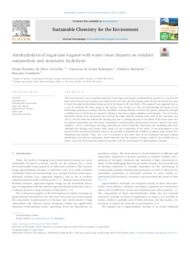Autohydrolysis of sugarcane bagasse with water reuse: Impacts on residues’ composition and enzymatic hydrolysis.
Autohydrolysis of sugarcane bagasse with water reuse: Impacts on residues’ composition and enzymatic hydrolysis.
Autoria: CARVALHO, F. B. de P.; RODRIGUES, D. de S.; MACHADO, F.; GAMBETTA, R.
Resumo: Abstract: This work presents a new sequential approach to the sugarcane bagasse autohydrolysis process in a way that the liquor from the previous reaction was reused in the next one, and the makeup water for the next batch was used to wash the solid fraction before being added to the liquor in the next batch. This approach was suggested first as a way of reducing the water usage in the process, and second as a way of concentrating the liquor in any interesting component, working with the possibility of losing efficiency towards the glucose production through a cellulose loss to the liquor or enzymatic efficiency loss from a higher inhibitor concentration. Two sets of five sequential batches were performed: one washing the solids with the makeup water prior to the enzymatic step (Set 2), and the other one without the washing step (Set 1), looking forward to the effects of the water reuse over the glucose production and the liquor composition. Autohydrolysis pretreatment removed most of the hemicellulose (?94?%), with liquor recycling improving its removal until the third batch and stabilizing after that. Although the washing step showed little impact on the composition of the solids, it was determinant to the success of the enzymatic hydrolysis, since it was possible to maintain the cellulose to glucose yield around 53% throughout the batches. There was a 64?% reduction in the water used in the sequential reactions without interfering in the glucose production, which indicates that the proposed strategy could be successfully used to reduce costs and environmental impacts associated with the pretreatment of lignocellulosic biomass.
Ano de publicação: 2024
Tipo de publicação: Artigo de periódico
Unidade: Embrapa Agroenergia
Observações
1 - Por padrão são exibidas publicações dos últimos 20 anos. Para encontrar publicações mais antigas, configure o filtro ano de publicação, colocando o ano a partir do qual você deseja encontrar publicações. O filtro está na coluna da esquerda na busca acima.
2 - Para ler algumas publicações da Embrapa (apenas as que estão em formato ePub), é necessário ter, no celular ou computador, um desses softwares gratuitos. Sistemas Android: Google Play Livros; IOS: iBooks; Windows e Linux: software Calibre.
Acesse outras publicações
Acesse a Base de Dados da Pesquisa Agropecuária (BDPA) para consultar o acervo completo das bibliotecas da Embrapa.

